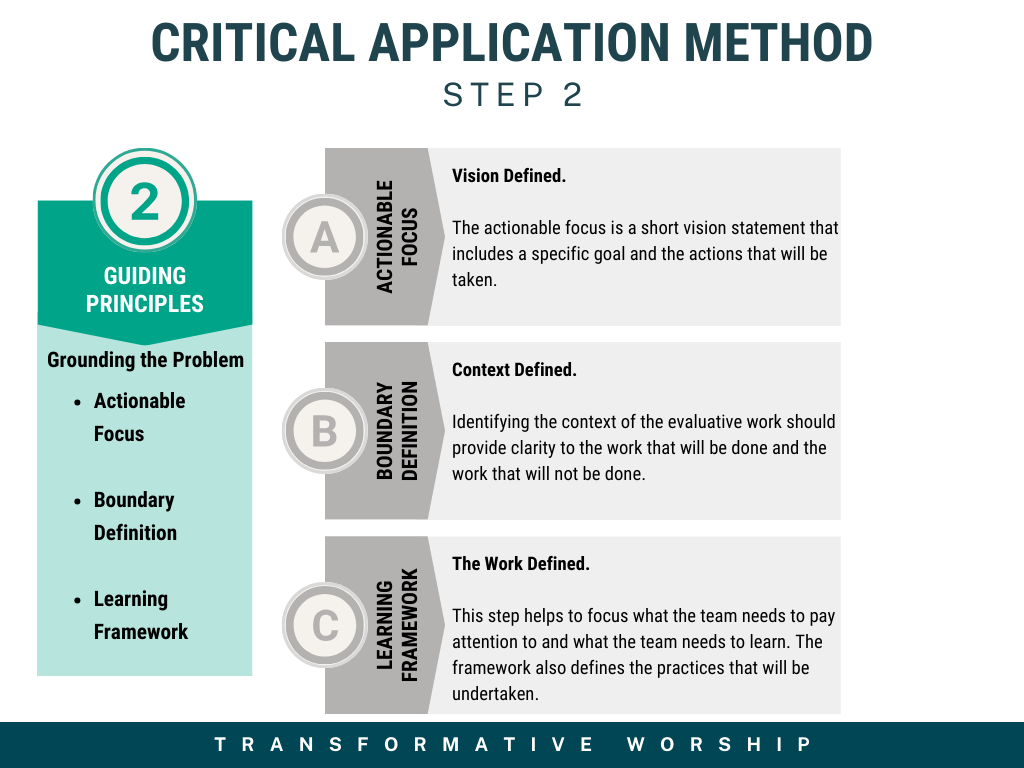GUIDING PRINCIPLES
In Step 2, the process of CAM helps practitioners to create guiding principles which frame the problem. This is especially important given the fact that developmental evaluation does not have a rigid process. Thus, the complex work that happens within a developmental evaluation can become overwhelming and disorienting.
In complex systems, it is easy to lose sight of the overarching “why” that grounds the work. In the context of developmental evaluation, guiding principles allows for an adaptive environment through which change becomes more grassroots in nature as it is “empowering and context-specific.”[1]
Guiding principles allow for the process of CAM to be flexibly bounded and, thus, adaptive. For the CAM process, guiding principles have three parts, an actionable focus, boundaries, a learning framework, and progress markers.
Step 2, Guiding Principles, have three components: Actionable Focus, Boundaries, and a Learning Framework.
Actionable Focus: An actionable focus clearly defines a compelling vision or direction for the CAM process. There are three key advantages to an actionable focus.
- The actionable focus “supports decision-making in the midst of chaos and uncertainty.”
- An actionable focus provides “guidance in situations where there is no formal direction.”
- An actionable focus, allows “stakeholders to act on their own initiative to further the collective undertaking of the group.”[2]
The actionable focus sets the tone for the rest of the guiding principles as this is the engine driving the work and the place to which the process returns as decisions are made, when there is confusion, and when there is disagreement. For an actionable focus to be effective, it should include a specific goal along with the actions that will be taken.
Boundaries: The process of setting boundaries is the work of identifying the context of the evaluation. Most importantly, within the work of setting boundaries, the recognition of what the work will and will not do. There is always more to be done than any endeavor can do. As practitioners engage the work of evaluation, they will need to decide what work they will and will not do at the same time, recognizing that boundaries develop and evolve.[3]
Part of the creation of creating guiding principles is the work of permission giving. As boundaries are set, practitioners also recognize that realigning boundaries is also within their purview.
Learning Framework: A Learning Framework defines how the group will learn together and then experiment with what has been learned.
Also, a learning framework begins by asking two fundamental questions:
- “What the group needs to pay attention to as they go forward”
- “What they need to learn.”[4]
The first step in the learning framework is to answer these two questions. Then, decide on different means of watching. Watching can happen through several different avenues including simply observing worship, providing spiritual development surveys, interviews with congregants, etc.
CAM uses and adaptation of David Kolb’s Experiential Learning Cycle[5] as the basis of the CAM Cycle and adapts it into three components: evaluation, adaptation, and implementation.
The idea for CAM came after reading James K.A. Smith’s Desiring the Kingdom in which he poses a set of questions that felt inherently important to the work of ministry, and I began to wonder what it would look like to put these questions to use in my ministry.[6] Smith poses these questions as a way of exegeting culture. However, I use them as a basis for the beginning of discussions that are meant to continually bring the end goal – spiritual transformation – to the forefront of liturgical creation within the church. These questions are addressed in the evaluation phase of the CAM Cycle.
References:
[1] Patton, Developmental Evaluation, 220.
[2] Dozoiss, Langloiss, and Blanchet-Cohen, “DE 201: A Pracitioner’s Guide to Developmental Evaluation,” 35.
[3] Patton, 34.
[4] Dozoiss, Langloiss, and Blanchet-Cohen, 31.
[5] Kolb, Experiential Learning.
[6] Smith, Desiring the Kingdom, 89.

